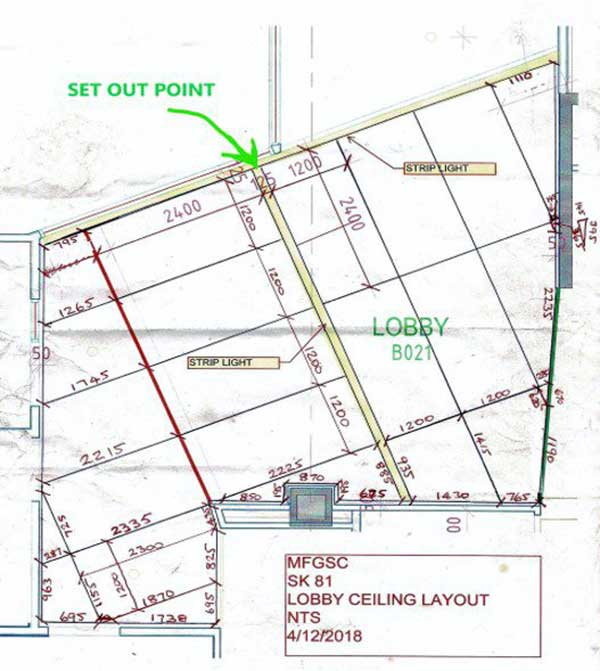General setting out warnings
- Assumptions and lack of communication are the prime reason installers end up with wrong size panels, framing in the incorrect position, or just a bad job with ugly perimeter details.
- Always begin with a discussion with your Supawood Project Manager. Our PMs will warn you about things you may not have considered and may stop you from making mistakes later on.
- Keep open channels of communication with the builder and even the architect, subject to protocols. Don’t hesitate to ask for a meeting, confirmed details, or updated drawings.
- If you experience any reluctance from a builder or contractor to communicate, ask them if they are prepared to risk something being done wrong.
Choosing set-out points
Correctly determining the set-out point/s is probably your most important decision of the installation. There are four types of set-out points to be aware of:
- Multiple set-out points. This is usually when you have panels aligned to corners, doors, window mullions, or similar.
- Centred set-out points. This is usually when you have standard size panels, which don’t have to align with anything in particular, so the centreline is centred in the space with equal or close to equal infill panels all around.
- Single set-out point. This is usually when the architect has provided a single set-out point, which may align with a prominent item in the room e.g., a column. Another typical situation is an L-shaped room, when the best set-out point is generally the inside corner of the L, so you can get panels aligned with both walls going away from this point.
- Combination. You may have a combination of the above in one room, for example, panels on one side of the room may need to align with doorways, but on the other end of the room the panels can be full size with infills.
Marking set-out points
- Mark the set-out point onsite on the floor or wall precisely where it will end up. This means you may need to allow for thickness of packing, framing, fixing battens and panel against adjoining walls, perpendicular surfaces, etc., so that the panel corner/ edge/ centre, will end up precisely where you have marked it. Watch out for joint intersections.
- Ensure you have marked the set-out point in such a way that it can’t be covered over or rubbed out by someone. If possible, make more than one mark, e.g., mark the other corners of the first panel.
- Double-check the latest architectural plan or shop drawing to ensure you have marked all set-out points.
- Double-check the final floor/ ceiling levels with the builder – these may even change from the architectural plans to allow for services that take up more space than expected.
Marking remaining panels
You have three options as to how to mark out the remaining panels, as follows:
- Set out the joint and size of the remaining panels across the rest of the ceiling or wall. You will need to work out your perimeter joints precisely to determine the size and position of your perimeter panels. This method must be used when you have multiple alignment points, e.g., panels aligning with stairs or lift doors.
- Use standard size panels with infill panels cut onsite. In the case of SUPACOUSTIC acoustic panels, if you are not sure of the position of the perimeter walls, you can determine the range of the final panel size within a tolerance of say, 50mm, and Supawood will make the border of this last panel 50mm bigger so that it can be cut onsite without cutting through the slots/ holes.
- Install all panels in the centre of the space and then measure from the edge of these to the perimeter walls to determine your infill panel sizes. The disadvantage of this method is that you can only order your infill panels after you have installed nearly all the centre panels, which will not suit most builders’ programs. It is typically only used on very large projects with hundreds of square metres of panel that have long fitout programs.
Determine framing position
You have two decisions to make with your framing install:
- What direction does your framing need to run; for example, will your framing run parallel with the long side or the short side of the panel? This will depend on the fixing system if the panels are concealed fixed, so check with your Supawood Project Manager which direction the framing must run, or inform him before panel manufacture, what direction you need it to run.
- What centres does your framing need to be installed at? Generally this is at a maximum of 600mm centres, with framing members positioned at the two edges and the centre of the panel. However, in some cases the framing may need to be at a maximum of 450mm centres, so check with your Supawood Project Manager.
- Plan special framing arrangements. Plan where you may need to do some special framing, for example, long spans underneath services, prefabricated shaped or curved framing sections, or bulkheads you will need to build. Some situations may require special panel modifications, so review these with your Supawood Project Manager.

Panel set-out points
We would love to help you with your next project. If you have a challenge right now that you would like us to help you with, please contact us here.
Read the second part of this blog: Panel setting out: SUPASLAT & SUPASLAT Aluminium.

